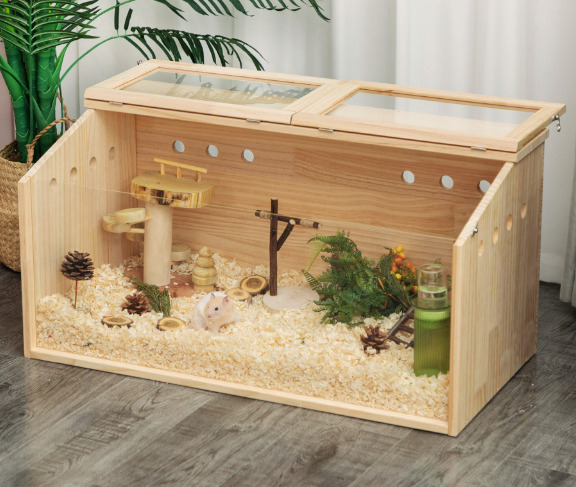When it comes to choosing a small pet, hamsters in hamster cages often top the list due to their adorable appearance and manageable size. However, the question of how friendly hamsters truly are can vary from person to person. In this exploration of hamster friendliness, we’ll delve into the factors that influence their social behavior and shed light on the potential for building meaningful connections with these pint-sized companions.
Understanding Individual Nature
Understanding Hamster Personalities
Hamsters in hamster cages, like humans, have distinct personalities. Some individuals may be naturally more sociable and open to interaction, while others may lean towards shyness or independence. The breed of hamster can also play a role in their temperament. Syrian hamsters, for example, are known for their solitary nature, while dwarf hamsters may be more inclined to enjoy the company of their fellow hamster friends.
Recognizing Signs of Contentment and Discomfort
Understanding hamster body language in hamster cages is crucial in gauging their comfort level. Signs of contentment include relaxed body posture, grooming behaviors, and a willingness to be handled. On the other hand, signs of discomfort or stress may include raised fur, rapid breathing, or attempts to escape. Respect your hamster’s boundaries and be attuned to their cues to ensure a positive and stress-free interaction.
Building Trust in Hamster Cages
Building Trust Through Patience
Hamsters are prey animals in the wild, and their natural instincts may include caution and wariness. Building trust with a hamster requires patience and a gradual approach. Begin by spending time near the hamster cages without making sudden movements or loud noises. Slowly introduce your hand into the cage, allowing the hamster to become accustomed to your presence. Over time, as trust is established, you can progress to gentle handling.
Gentle Handling Techniques
When handling your hamster in hamster cage, adopt gentle and calm techniques. Approach from the side rather than from above, as this can mimic the way a hamster might be approached by a potential threat in the wild. Support their body with both hands, ensuring they feel secure. Avoid sudden movements or loud noises that might startle them.
Habituation to Scent and Voice
Hamsters rely heavily on their sense of smell, and they often recognize individuals by scent. Spend time near the hamster cage, allowing your hamster to become familiar with your scent. Additionally, hamsters can be responsive to voices. Speaking to your hamster consistently, especially during feeding or playtime, can help them associate your voice with positive experiences, contributing to a stronger bond.

Positive Reinforcement in Hamster Cages
Positive Reinforcement for Bonding
Like many pets, hamsters respond well to positive reinforcement. Offer treats, such as small pieces of fruit or hamster-friendly snacks, during interactions to create positive associations. Speak to your hamster in a calm and soothing tone to further strengthen the bond. Consistent positive experiences in hamster cages will contribute to a hamster feeling secure and comfortable in your presence.
Training with Tasty Treats
Training your hamster in hamster cage with treats not only reinforces positive behavior but can also be a fun and interactive experience. For example, you can use treats to encourage them to climb onto your hand or explore new toys. This positive reinforcement creates a positive association between you and the reward, making the training process enjoyable for your hamster.
Enrichment in Hamster Cages for Well-being
Enrichment and Playtime
Hamsters are active animals that benefit greatly from mental and physical stimulation. Provide a variety of toys, tunnels, and climbing structures within their hamster cages to keep them engaged. Designate a safe and secure play area outside the cage for supervised playtime. This not only allows your hamster to explore and exercise but also provides opportunities for interaction and bonding.
Environmental Considerations
The environment in which your hamster lives plays a significant role in their overall well-being and friendliness. Ensure their hamster cage is appropriately sized, well-ventilated, and equipped with hiding spots and comfortable bedding. A stress-free environment contributes to a content and sociable hamster.
Companionship Considerations
While some hamsters may enjoy solitary living, others may thrive in the company of a same-sex companion. If considering housing multiple hamsters together, be sure to research the specific needs and compatibility of the chosen species. Introduce hamsters gradually and monitor their interactions to ensure a harmonious hamster cage arrangement.

Respect for Individual Preferences and Boundaries
Respecting Nocturnal Habits
Hamsters are nocturnal creatures, meaning they are most active during the night. Attempting to interact with them during their sleep cycle might lead to stress or irritability. Schedule playtime and handling sessions during the evening in hamster cages when your hamster is naturally more awake and alert. Respecting their nocturnal nature enhances the chances of positive interaction.
Adapting to Individual Preferences
Each hamster is unique, and what works for one may not work for another. Pay attention to your hamster’s individual preferences and boundaries. Some hamsters in hamster cage may enjoy cuddling, while others may prefer to explore and play. By adapting your interaction style to suit your hamster’s personality, you can create a more comfortable and enjoyable experience for both of you.
The friendliness of hamsters is a nuanced aspect of their personalities that depends on various factors, including individual temperament, breed, and previous experiences. By approaching hamster interaction with patience, positive reinforcement, and an understanding of their natural instincts, you can foster a bond with these charming pets. Whether your hamster in hamster cages leans towards a more reserved demeanor or is eager for interaction, the key lies in respecting their preferences and providing a nurturing environment for them to thrive as your lovable, furry companion.